coarse - Of low, common, or inferior quality. Lacking in refinement or delicacy. Indecent or vulgar. Or, consisting of large particles, not fine in texture. Do not confuse it with course, which is pronounced identically.
(pr. kohrs)
Also see obscene, pornography, and sand.
coat and coating - A coat is a layer of material covering something else, which might also be termed a coating. Or, to cover with a layer, as of ink, paint, or silicone rubber. Something described as coating well is thoroughly opaque with the application of one layer.
Also see canvas, gesso, ground, nail, panel, paper, polyurethane, primer, size, and support.
coated paper - A paper surface with white clay or an acrylic substance to provide a smooth printing or drawing surface. This surface is usually glossy, but can also be mat.
Also see lustrous.
coat of arms - An arrangement of shapes and figures — called bearings — usually depicted on and around a shield, that indicates ancestry and distinctions. In heraldic terms, this is also termed a "complete achievement." Heraldry governs the terms used to describe bearings and their arrangement in coats of arms. Completely describing a coat of arms in heraldic terms is called blazoning.
Examples:

Albrecht Dürer (German, 1471-1523),
The Dürer
Coat of Arms, 1524, engraving. Dürer's monogram
can be seen at the top center of this design. See Northern Renaissance.
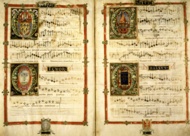
Italian, 16th century, Illumination of "Conditor alme siderum",
a Renaissance
period hymn composed by Costanzo Festa (Italian, c. 1480-1545),
c. 1538, Collection of Polyphonic Hymns and Magnificats, Vatican,
Rome. The arms of the reigning pope Paul III on the elaborately
decorated "Q" in the upper left. The coat of arms at
the bottom of the right-hand page — lions holding a wreath with
a fleur-de-lis — may be the composer's personal coat of arms.
This work is catalogued as "Capp. Sist. 18 fols. 3 verso
- 4 recto music06 NB.36"
See historiated and music.
![]()
Italian, Coat of Arms of Cardinal Scipione Borghese,
c. 1620, bronze,
57 x 37 inches, Minneapolis Institute of Arts. The eagle and
dragon emblazoned on the shield of this coat of arms are heraldic
symbols of the Borghese family.

England, Lambeth, c. 1690, Pill Slab with the Arms of the Society of Apothecaries and the City of London, tin-glazed earthenware (Delftware), 10 5/8 x 9 5/8 inches (26.99 x 24.45 cm), Los Angeles County Museum of Art.
Mauro Pieroni (Italian, contemporary Florentine), carver, Royal Coat of Arms of the United Kingdom's Queen Elisabeth II, carved and painted wood.
Also see ancipital, arms & armor, bookplate, monogram, and tradition.
cobalt - A metal resembling nickel from which a range of pigments are made, most notably a deep, rich blue, derived from this mineral's oxide.
![]()
Handle cobalt with extreme caution. Hazards associated with this element demand stringently clean handling procedures.
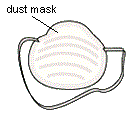
 Cobalt came to English from the German word Kobold, the name of a particular evil spirit, who some spoke of as a wicked goblin. German miners dreaded Kobold's presence, blaming it for ills associated with the extraction of cobalt from the earth. The miners blamed Kobold for all sorts of other mine disasters too. Accept this cautionary tale, that you and all for whom you care had best BEWARE the dangers of Kobold . . . er, cobalt.
Cobalt came to English from the German word Kobold, the name of a particular evil spirit, who some spoke of as a wicked goblin. German miners dreaded Kobold's presence, blaming it for ills associated with the extraction of cobalt from the earth. The miners blamed Kobold for all sorts of other mine disasters too. Accept this cautionary tale, that you and all for whom you care had best BEWARE the dangers of Kobold . . . er, cobalt.  Examples:
Examples:

England, Lambeth, c. 1690, Pill Slab with the Arms of the Society of Apothecaries and the City of London, cobalt blue, tin-glazed earthenware (Delftware), 10 5/8 x 9 5/8 inches (26.99 x 24.45 cm), Los Angeles County Museum of Art. See coat of arms.
![]()
English, Delft Vase, 1700-1725, ceramic, 6 x 3 3/4 inches, Minneapolis
Institute of Arts. Delft potters famously used cobalt blue glazes. See vase.

English, Delft Barber's Bowl, c. 1720, ceramic, delftware, 3 1/2 x 10 1/4 inches,
Minneapolis Institute of Arts.

English, Delft Tile, c. 1750, ceramic, delftware, 5 1/16 x 5 1/16
x 5/16 inches, Minneapolis Institute of Arts. See tile.
Related resources:
Cobra or COBRA - A twentieth century European art movement whose members included Pierre Alechinsky, Karel Appel, Corneille, Egill Jacobsen, Asger Jorn, Lucebert, and Karl H. Pederson, and was founded in Paris in 1948 by the Belgian poet and essayist Christian Dotrement, and active until 1951. Their art was experimental, inspired by Marxism, somewhat sympathetic to Expressionism and Surrealism, showing greatest affinity to folk art and children's art and to the works of Paul Klee and Joan Miró. Similarities can also be seen to works by American abstract expressionists, but none to those that are geometrically abstract. Cobra's name was distilled from the names of the three capital cities of the countries of its principal members: CO from Copenhagen, Denmark, BR from Brussels, Belgium, and A from Amsterdam, The Netherlands.
Examples:
Karel Appel (Dutch, 1921-2006), Questioning Children (Vragende kinderen), 1948, relief: pieces of wood nailed onto a wooden panel, painted with oil, 85 x 56 cm, Georges Pompidou Center, Paris.
Karel Appel, Questioning Children (Vragende kinderen), 1949, relief: pieces of wood nailed onto a wood panel, painted with oil, 87.3 x 59.8 x 15.8 cm, Tate Gallery, London.
Pierre Alechinsky (Belgian, 1927-), The Lost World, 1959, oil on fine linen, 204 x 308 x 9.7 cm, Georges Pompidou Center, Paris.
Also see art brut.
codex - A manuscript book, its text handwritten on a number of separate pages. A codex cannot be mechanically printed nor can it be written on a rolled scroll. The plural form is codices. The earliest known ones date from the fourth century CE. In Mesoamerican art, a painted and inscribed book on long sheets of fig-bark paper or deer skin coated with plaster and folded into accordion-like pleats.
Examples:

Mixtec (southern Mexico), Codex Zouche-Nuttall, 1200-1521, deer skin, 47 leaves, British Museum, London. This is one of only four known Mexican codices to survive the Spanish invasion of 1518-21.

Mexico, Aztec, Codex
Borbonicus (facsimile consisting of the 14th folio);
the original Codex Borbonicus c. 1507, or perhaps between 1522 and 1540,
15 1/2 x 15 5/8 inches, Bibliotheque de l'Assemblee Nationale,
Paris.
Also see bookbinding, duodecimo, folio, leather, quarto, octavo, rotulus, sextodecimo, signature, text, tricesimo-segundo, vellum, and vicesimo-quarto.
coefficient of expansion - The degree in change of size caused by heat. Also see measure and temperature.
coffer or coffering - In architecture, sunken panels in a soffit, ceiling, vault, or dome; often ornamental.
Example:
![]()

![]()
Coffered Dome of the Pantheon, c.
118-128, interior view, Rome. Another view of the interior.
See oculus
and pantheon.
cognitive - Having to do with the mental process or faculty of knowing, including such things as analysis, application, awareness, comprehension, perception, reasoning, synthesis, evaluation, and meta-cognition.
Quote:
Also see art therapy, Bloom's Taxonomy, epistemology, genius, knowledge, meaning, motivation, multiple intelligence theory, research, and science and art.
coherence, coherent - Coherence is a quality of having logically or aesthetically ordered or integrated parts that afford comprehension or recognition. One of the principles of design, coherence is largely synonymous with unity. A whole is coherent if its parts are so ordered or integrated. Incoherence is the opposite of coherence.
Also see arrangement, balance, chaos, closure, communication, comparison, composition, comprehension, contrast, gestalt, harmony, irony, juxtaposition, knowledge, and meaning.
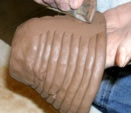
 coil and coil method or coil construction
- Coils are long, snake-like ropes of clay
that are used in making pottery.
The coil method of making pottery involves building the walls
of a pot with a series of coils into the required shape. Once
the desired height has been reached the surface
can either remain coil-textured
or they can be smoothed. Much pottery in primitive
cultures was made this way, and
remains one of the principle hand-building technique
potters use.
coil and coil method or coil construction
- Coils are long, snake-like ropes of clay
that are used in making pottery.
The coil method of making pottery involves building the walls
of a pot with a series of coils into the required shape. Once
the desired height has been reached the surface
can either remain coil-textured
or they can be smoothed. Much pottery in primitive
cultures was made this way, and
remains one of the principle hand-building technique
potters use.
Also see helix, pinch, slab construction, potter's wheel, and volute.
coin - See numismatics and currency.
cold chisel - A toughened steel chisel used to cut metal when it is cold.
cold-pressed paper - A smooth watercolor paper.
collagraph - A print made from a low relief collage.
collaring - Part of the ceramic technique of throwing a pot on a potter's wheel. Collaring is constricting the top of the pot to prevent the wet clay from flaring out. Not to be confused with a collograph.
collect, collection, collector - To collect is to accumulate objects. A collection is an accumulation of objects. A collector is a person who makes a collection.
Someone said that as soon as you have three of something, you have a collection. Another said that a compulsion to acquire can be explained psychologically as a "hedge against mortality" — we die, but our stuff lives on. It's actually much more complicated than that, the reasons being nearly as various as the number of collectors. Numerous books have been written about collectors and collecting.
Collections can be formed around any of a variety of parameters. They may be centered upon a medium or technique, a certain period or group of artists, or a subject, for instance; or they may be encyclopedic, as can be the entire collection of a large museum. Museums typically have both permanent collections and traveling collections.
Example:
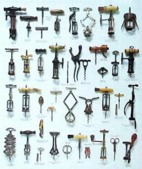
A collection of forty corkscrews mounted
with text labels on a white board.
A collection of objects of this size
might be displayed best in a shadow
box or a vitrine. Consider
the means of display chosen by the Virtual Corkscrew Museum.
Quote:
Also see accession, bin, bookplate, collectible, Collyers' Mansion, concatenation, deaccession, donation, ephemera, exhibit, frame, gallery, iconoduly, iconography, Kunstkabinette, Kunstkammer, memorabilia, museology, patron, philately, polypropylene, portfolio, posterity, UNESCO Convention on the Means of Prohibiting and Preventing the Illicit Import, Export and Transfer of Ownership of Cultural Property, UNIDROIT Convention on Stolen or Illegally Exported Cultural Objects, Wunderkabinette, and Wunderkammern.
collectible, collectable - An object of a type that is valued or sought after by collectors. This term is used less with high art than it is with crafts, memorabilia, and other objects that are becoming rarer, and were previously little recognized as worthy of collection. Another sort of collectible is that which is designed to be marketed as instantly collectible. Examples include sports cards, certain toys, medals, porcelain plates and figurines. At worst, "collectible" is applied in a calculated and inauthentic manner by manufacturers and sellers of new products to increase their appeal, when otherwise those things are simply gewgaws, tchotchkes, kitsch, or replicas. Some of the earliest collectibles of this sort were included as incentives with other products, such as cigarette cards in packs of cigarettes. Popular items developed a secondary market and sometimes became the subject of "collectible crazes," as occurred with Beanie Babies and Pokemon cards, manufactured, as many collectibles are, in series, in order to encourage the gradual buying of larger and larger collections. The early versions of a product, manufactured in smaller quantities before demand has begun to grow, sometimes command exorbitant prices on the secondary market. In a mature market, collectibles rarely prove to have been a sound investment. Although some authorities accept "collectable" is an alternative spelling, it is commonly considered incorrect. According to a study of Usenet traffic several years ago, "collectible" was among the most frequently misspelled of words.
Examples:


American, American Tobacco Company, Ty Cobb
Baseball Card, Detroit Tigers, 1911, chromolithograph,
Library of Congress, Washington, DC. Packaged as a giveaway with
tobacco, chewing-gum, and other products, such cards have always
been collectible. Nevertheless, even the rarest
cards were discarded by many whose intent was merely to smoke
or chew the product they'd bought, never dreaming that the giveaway
card might be worth a fortune some day.

Ty Incorporated, Three Hippity Hoppity Bunnies, beanie
babies, mixed media, the
length of each about 6 inches.
The first of Ty's small, plush dolls appeared on the market in
late 1996. Millions of people joined a craze to acquire what
were hyped as instant rarities.
Hearing stories of windfalls to early purchasers, many later
ones hoped to make a fortune later. By 2000 the fad had passed,
and many collectors found themselves surrounded by cute
pieces of a popped economic bubble.
Also see artifact, artificial, ephemera and monetary worth.
 College
Art Association (CAA)
- Founded in 1911, the College Art Association promotes excellence
in scholarship and teaching in the history
and criticism of the visual arts, and in creativity and technical
skill in the teaching and practices of art. It facilitates the
exchange of ideas and information among those interested in art
and the history of art. It advocates
comprehensive and inclusive education in the visual arts. It provides
opportunities for publication of scholarship, criticism, and artists'
writings. It fosters career development and professional advancement.
It identifies and develops sources of funding for the practice
of art and for scholarship in the arts and humanities.
It honors accomplishments of artists, art historians, and critics.
It articulates and affirms the highest ethical standards in the
conduct of the profession. The CAA includes among its members
those who by vocation or avocation are concerned about art and
art education. Over 13,000 artists, art historians, scholars,
curators, collectors,
educators, art
publishers, and other visual arts professionals are individual
members. Another 2,000 university art and art history departments,
museums, libraries,
and professional and commercial organizations hold institutional
memberships. The CAA administrative office is located at 275 Seventh
Avenue, New York, New York 10001. Phone 212.691.1051 Email nyoffice@collegeart.org
College
Art Association (CAA)
- Founded in 1911, the College Art Association promotes excellence
in scholarship and teaching in the history
and criticism of the visual arts, and in creativity and technical
skill in the teaching and practices of art. It facilitates the
exchange of ideas and information among those interested in art
and the history of art. It advocates
comprehensive and inclusive education in the visual arts. It provides
opportunities for publication of scholarship, criticism, and artists'
writings. It fosters career development and professional advancement.
It identifies and develops sources of funding for the practice
of art and for scholarship in the arts and humanities.
It honors accomplishments of artists, art historians, and critics.
It articulates and affirms the highest ethical standards in the
conduct of the profession. The CAA includes among its members
those who by vocation or avocation are concerned about art and
art education. Over 13,000 artists, art historians, scholars,
curators, collectors,
educators, art
publishers, and other visual arts professionals are individual
members. Another 2,000 university art and art history departments,
museums, libraries,
and professional and commercial organizations hold institutional
memberships. The CAA administrative office is located at 275 Seventh
Avenue, New York, New York 10001. Phone 212.691.1051 Email nyoffice@collegeart.org
collodion wet plate - A photographic process invented in 1851, involving the use of a thick glass plate on which to create a negative, exposing it in the camera with its emulsion still wet. Also called wet plate and wet collodion process. It was the standard photographic process for a time, replaced in the 1870s by the gelatin dry plate process.
Examples:
Nadar [Gaspard-Félix Tournachon] (French, 1820-1910), Alexandre Dumas père (1802-1870), 1855, salted paper print from wet collodion negative, Cleveland Museum of Art.

Carleton E. Watkins (American, 1829-1916),
Bridal Veil, Yosemite, c. 1865-1866,
albumen print from wet collodion
negative, Cleveland Museum of Art.
Also see positive.
collograph - A print made from an image built up with glue and sometimes other material. The inked image is transferred from plate to paper and is simultaneously embossed. The name derives from collage. Not to be confused with a collagraph or a collotype.
collotype - A photographic printing process in which a glass plate whose surface has been coated with gelatin carries the image to be reproduced. Also called a photogelatin process.
Examples:

Eadweard Muybridge (American, born in England,
1830-1904), Jumping a hurdle; saddle; bay horse Daisy
Plate 640 of Animal Locomotion, 1887, collotype, Worcester
Art Museum, MA. See animation,
cinema, equine
art, movement,
and time.
Max Ernst (German, 1891-1976), The Hat Makes the Man, 1920, gouache, pencil, ink, and collaged collotypes, 14 x 18 inches (35.6 x 45.7 cm), Museum of Modern Art, NY. See Dada.
Related link:
Also see negative.
Collyers' Mansion - A residence so packed with piles of possessions that it presents a fire hazard. Accumulations of material are obstacles to walking through the rooms or halls of such a place. The term is most common among firefighters in eastern USA. It originated in 1947, when the brothers Homer and Langley Collyer were found dead in their Harlem dwelling amid an estimated 100 tons of obsessively stockpiled debris, including "stacks of phone books, newspapers, tin cans, clocks, and a fake two-headed baby in formaldehyde" (Newman, 2006). In other regions of America, firefighters sometimes call such a space a packer house, a habitrail house, pack-rat conditions, or heavy debris. In the art world, such an environment might be described as a residence, studio or storeroom that displays horror vacui in its collections of material culture. This miscellany might include art supplies and objects, but emphasize ephemera, bric-a-brac, and other detritus.
Reference
See also folk art, storage, visual culture, and Wunderkammern.
colonnade - A row of columns supporting arches, a lintel, or an entablature. Colonnades have been used along streets, courtyards, and around temples such as the Parthenon. (pr. kah'le-nayd")
Examples:
Egypt, Luxor, c. 1400-1360 BCE (18th Dynasty), Temple of Amon, Hypostyle Colonnade, There are seven papyrus-bundle columns fifty-two feet high on each side of the passage.
Ducal Palace, fourteenth century, Venice, Italy. As in the previous example, the palace has colonnades on its first two stories; the upper a gallery.
Also see architecture, acropolis, balustrade, Greek art, intercolumniation, loggia, pergola, peripteral, peristyle, portico, and Roman art.
colonnette - A small column.
colophon - The logo of a printer or publisher. Or an inscription page sometimes found at the end of a book, noting information about the design of the book. This information might identify the font, paper, or bookbinding.
Examples:
Ahmad ibn al-Suhrawardi al-Bakri (calligrapher, Baghdad, Iraq, Ilkhanid), Colophon page from a Qur'an manuscript, non-illustrated detached folio, 707 A.H. / 1308 CE, ink, colors, and gold on paper, height 20 3/16 inches (51.3 cm) width 14 1/2 inches (36.8 cm), Metropolitan Museum of Art, NY. See calligraphy, Islamic art, and page.
![]()
![]()
Random House.
![]()
![]()
![]()
Borzoi is an imprint of Alfred A. Knopf,
a part of Random House, which is in turn owned by Bertelsmann.
There have been many versions of the Borzoi colophon since the
early 20th century.
![]()

Crown is another imprint of Random House.
![]()
![]()
Penguin Books.
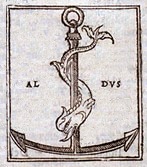
Colophon of the publisher Aldus Manutius
(Italian, 1450-1515), established the Aldine Press in 1493 in
Venice to published numerous Greek and Latin classics, greatly
contributing to the spread of the Renaissance.
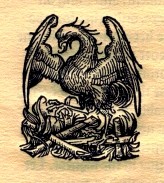
Colophon at the end of the last page of The Art of
Printing Books, by Dr. Hartmann
Schedel, from the Nuremberg Chronicle, 1493, as printed
in 1977 by King Library Press, U of Kentucky, Lexington.
Also see glyph.
colorant - A substance, such as a dye or pigment, that colors something else. A colorant may be raw or refined chemical, mineral, or herbal material. Also see mortar and pestle.
colorblind or color-blind, and colorblindness
color correction - The process of altering colors as they appear in a digital image or in print to insure they accurately represent the work depicted.
color depth - See dynamic range.
color look-up table - In digital imaging, a palette used in the selection of colors. It is also known as CLUT.
Examples:
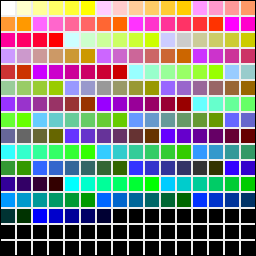
A color look-up table displaying the 216
browser-safe colors — those that can be displayed on the Web.
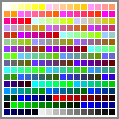
Here is another color look-up table of 256
colors, designed for Apple's Macintosh computers.
See 8-bit image, 12-bit image, 24-bit image, color wheel, eyedropper, and palette.
color management systems - In digital imaging, systems that attempt to produce consistency in the representation of color in image files, across image capture, display, and output devices.
color permanence - See permanent pigment.
color scheme - A set of colors that are used in an artwork, and the way they are combined in an artwork; sometimes called a palette. A color scheme is particularly harmonious if its colors are aesthetically compatible with a root color. In devising such a palette, artists might employ theories or principles of color harmony. Examples include achromatic, monochromatic, complementary, analogous, split complementary, and triadic (three) color schemes.
Quotes:
Also see colorways and tonal key.
color separation - A photomechanical graphic process used by commercial artists which separates the primary colors in a color picture. A printing plate is then made for each of the colors — one for yellow, one for blue (cyan), one for red (magenta), and also one for black. When these colors are printed one on top of the other, the full color original picture is reproduced.
color space - In digital imaging, a means of representing the color spectrum.
colorways - Color schemes when a pattern is produced in more than one.
Example:
A quatrefoil
design for fabric and wallpaper
in five colorways.
colour-man or colourman - A seller of colours (colors) — pigments and paints. Or a colourer — one who adds color to a black and white print. Although a colorman might sell other supplies as well as paints, use of this title decreases as the sales of artists' colors are increasingly made by sellers of a variety of artists' materials. This term has been used almost entirely in Britain. The Oxford English Dictionary has noted uses of "colour-man" and "colourman" from the late seventeenth century through the nineteenth century.
A twentieth century use:
column - An upright pillar or post, often used to bear weight. Columns usually consist of a base at the bottom, a round shaft tapering toward the top, and a capital. A half-column is attached to a wall and does not bear weight. Half-columns were used for decorative purposes on the Temple of Fortuna Virilis in Rome.
Examples of columns:
A schematic diagram of the Doric order and a diagram of the Ionic order.

Roman,
Rome, Colosseum
(Flavian Amphitheater), 70-82 CE.
A vast ellipse in plan,
length 620 feet x width
513 feet (188 x 156 m), with eighty external arcaded
openings on each storey, those on the ground floor forming entrances
from which the various tiers
of seats were reached. The upper storey was added 222-224, around
the top of which were sockets for 240 wooden masts which carried
a massive canopy (velarium). The façade's
entire height is 157 feet 6
inches (48.5 m). Each of the four storeys are pierced by arches, and have attached
three-quarter columns and entablatures,
Doric in the first story,
Ionic in the second, Corinthian in the third, and
above these are pilasters
of Corinthian design, with small square window openings in alternate
bays. Another view of the exterior and a cutaway view.
Constantin Brancusi (French, born Romania, 1876-1957), Endless Column, 1937-38, metal-coated cast-iron modules on a steel spine, height 98 feet, Târgu-Jiu, Romania. It was restored and reassembled in 2000, as seen here. Endless Column is one of three elements in a sculptural ensemble. the other two works are the travertine Table of Silence and the Gate of the Kiss. The Endless Column was conceived as a monument to young Romanians who died in World War I. See vertical.
Related link:
Also see abacus, architecture, atlantid, caryatid, classical orders, colonnette, dolmen, echinus, entasis, Greek art, intercolumniation, Ionic, pedestal, pier, pilaster, reserve column, respond, Roman art, socle, and stylobate.
combine - Any painted assemblage that is neither simply painting or sculpture, but rather a hybrid or interdisciplinary painting-sculpture. The term "combine" was coined by Robert Rauschenberg (American, 1925-).
(pr. KAHM-bi:n)
Examples:

Robert Rauschenberg (American, 1925-), Bed, 1955, combine painting: oil
and pencil on pillow, quilt,
and sheet on wood supports, 6 feet 3 1/4 inches x 31 1/2 inches
x 8 inches (191.1 x 80 x 20.3 cm), Museum of Modern Art, NY.
See textile.
Jasper Johns (American, 1930-), Target with Four Faces, 1955, assemblage: encaustic and collage on canvas with objects, 26 x 26 inches.
Also see Pop Art, signature, and specific objects.
commemorate - To honor or to serve as a memorial or monument to.
Also see column, desco da parto, donation, memory, monolith, obelisk, pillar, plaque, posterity, and Seven Wonders of the Ancient World.
commercial art - Works which involve creating images and objects for commercial purposes, rather than for fine art ones. Today the term more commonly used for commercial art is simply design -- especially three-dimensional works, with two-dimensional works referred to more specifically as graphic design.
Also see craft, high art, monetary worth, and popular culture.
commission - The act of hiring someone to execute a certain work or set of works. Such an act is often made in the form of a contract. Commission may refer to a work executed under such an agreement. Also, a group of people officially authorized to perform certain duties or functions, such as the Arizona Commission on the Arts and the Phoenix Arts Commission. The first example is a branch of a state's government, while the second is a branch of a city's government. And, commission may refer to a fee or percentage allowed to a sales representative or an agent for services rendered.
Also see monetary worth, new media, patron, public art, and specifications.
commodity and commodification - Something which can be bought and sold; an article of trade. Referring to an artwork as a commodity minimizes its significance in other ways — as an expression of an artist's feelings, allegory, formal issues, etc. Bringing out this aspect in an object is called commodification.
Quote:
Related link:
Also see artifact, artwork, collectible, collection, conceptual art, deaccession, manufacture, market value, object, and piece.
communication - Conveying information; exchanging ideas, etc., in such a way that they are coherent. A notion underlying popular ideas of art — that is, that an artwork is made to convey something specific that the artist had in mind, and making an artwork is primarily a matter of finding the means to make that something understood. In the 1960s, Minimalists entirely rejected the validity of this point of view, largely in favor of formalist issues. Ideas are not enough; one needs to get them into the minds of others.
Quote:
Also see attitude, bias, expression, graphic design, knowledge, interpretation, meaning, and straight.
compare, comparison - To compare is to examine, describe, and analyze two or more things for qualities that are equal, similar, analogous, or different. Also, to liken one thing to another — to note how they resemble each other, or how they may be equal or similar in quality or standing. When paired with "contrast," "compare" emphasizes similarities while "contrast" emphasizes differences. A comparison is an instance of comparing. The act of comparing is often called "drawing a comparison," even though comparing needn't have anything to do with making a drawing.
"Compare to" or "compare with"? "Compare to" is used when things are being likened in general ways. "Compare with" is used when the comparison is more specific and implies differences as well as similarities. Some grammarians say that when compare is used intransitively (i.e., without an object), "with" should always be used, but others say that either "with" or "to" are acceptible in this context.
"Paragone" is an Italian word meaning "comparison." In art, this is a critical term referring to the debate begun in the 16th century and continued in the 17th about the relative merits of painting and sculpture. To the degree that this is analogous to historical arguments over political, racial, and religious questions, do you think this argument will ever be settled?!
(pr. kəm-PAYR and kəm-PEH-rə-sən)
Example:

Compare these two images of a poster produced with Adobe
Illustrator. The first is a line drawing, a simplification of
the second image — the final version.
Also see accent, art criticism, art history, camouflage, charette, choose, concatenation, consistency, counterpoint, critique, emphasis, focal point, image processing, interesting, frisson, gestalt, harmony, incoherence, incongruity, irony, likeness, metaphor, overlay, sequence, tension, unity, and variety.

compass - A mechanical tool that has two hinged, adjustable legs for drawing different sizes (radius / diameter) of circle and arcs. One of the legs has a sharp steel point that is placed on one spot on the paper. The other can hold either a pencil, a pen or a blade, determines the circle's size, and that rotates around the pointed end.
Also see angle, curve, freehand, mechanical drawing, protractor, and scissors.
![]()
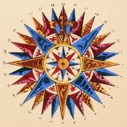
![]()
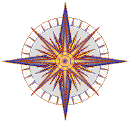
![]()
![]()
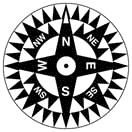
![]()
compass rose - A symbol typically found on maps; it indicates the direction of north, as well perhaps of others. Although each of the examples illustrated here point in thirty-two directions, some compass roses point in one, four, eight, sixty-four, or more directions.
Also see boss, cruciform, mandala, pattern, radial, rondel or roundel, rosette, template, and tondo.
compensation - See rule of compensation or monetary worth.
complementary afterimage - The afterimage (in a complementary color) that is retained briefly by the eye after the stimulus is removed.
Examples:
Stare at the + in the middle of the blue figure for 15-30 seconds. Then move your gaze to the + in the center of the white square on the right.

The reversal of colors you saw was this phenomenon called an afterimage. Note how briefly (or how long) the afterimage endured before it was gone.
Here are links to three interactive demonstration
of afterimages. You must use a JAVA-capable browser to see them
properly: the first one, second: "put the fish in the fishbowl," and third:
"change the colors of this flag."
Also see colorblind, optical illusion, persistence of vision, sight, and subliminal message or subliminal advertising.
complementary colors - Colors that are directly opposite each other on the color wheel, such as red and green, blue and orange, and violet and yellow. When complements are mixed together they form the neutral colors of brown or gray. Note that this term is spelled differently than the word "complimentary," which means gift.
Related link:
Also see analogous colors, benizuri-e, color scheme, monochromatic colors, split complementary, and triadic colors.
complexity - Closely related to variety, a principle of design, this term refers to a way of combining the elements of art in involved ways, to create intricate and complicated relationships. A picture composed of many shapes of different colors, sizes, and textures would be called complex.
Also see monotony, Rube Goldberg, simplicity, and unity.
compluvium - An opening in the center of a roof of a Roman atrium to admit light.
(pr. kəm-PLOO-vee-əm)
Also see fenestration, oculus, and Roman art.
compose - To create, put together, or arrange the elements of art in a work, usually according to the principles of design.
Also see creativity and homogeneity.
composite order and composite capital - A Roman order with its capital designed as a fusion of the Ionic and Corinthian orders.
Related site:
Also see classical orders and Roman art.
compound pier - A pier composed of a group or cluster of members, especially characteristic of Gothic architecture. Also called a cluster pier.
comprehension - The ability to grasp the meaning of material. Comprehension represents the second level of learning outcomes in the cognitive domain — one step beyond knowledge — the simple remembering of material. Objectives of lessons which will increase a student's comprehension can be stated with such behavioral terms as: calculate, cite, comprehend, compute, conclude, construe, convert, debate, define, demonstrate, discuss, document, dramatize, estimate, expand, explain, express, extend, extrapolate, generalize, give examples of, identify, illustrate, infer, interpret, locate, paraphrase, predict, propose, recognize, report, restate, review, suggest, summarize, support, tell, and translate. The next higher thinking skill is application.
Also see Bloom's Taxonomy and coherence.
computer graphics - Pictures made with the assistance of computers. Computer graphics are often made with software called drawing, painting, illustrating and photographic programs or applications.
Related links:
Also see Adobe,
analog, CAD,
digital image, graphic
design, monitor, and
photomechanical graphic.
https://inform.quest/_art